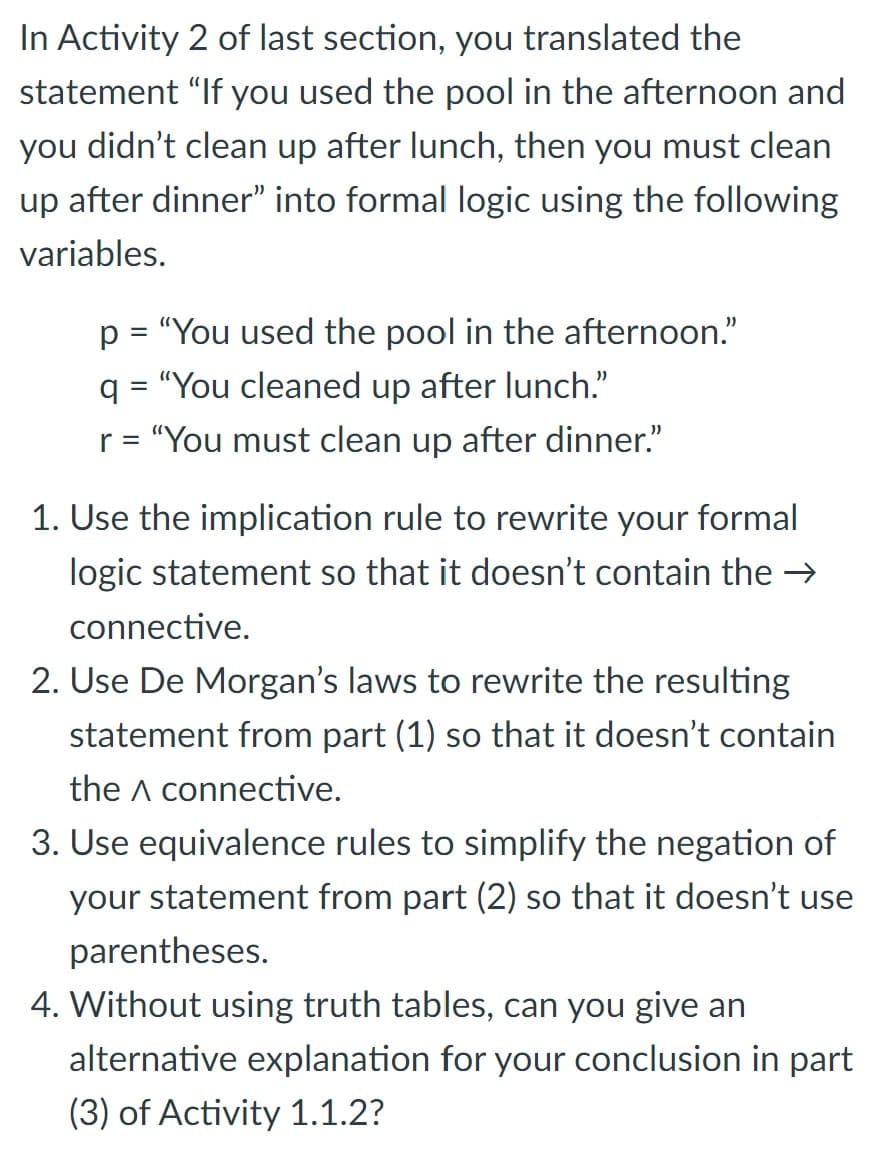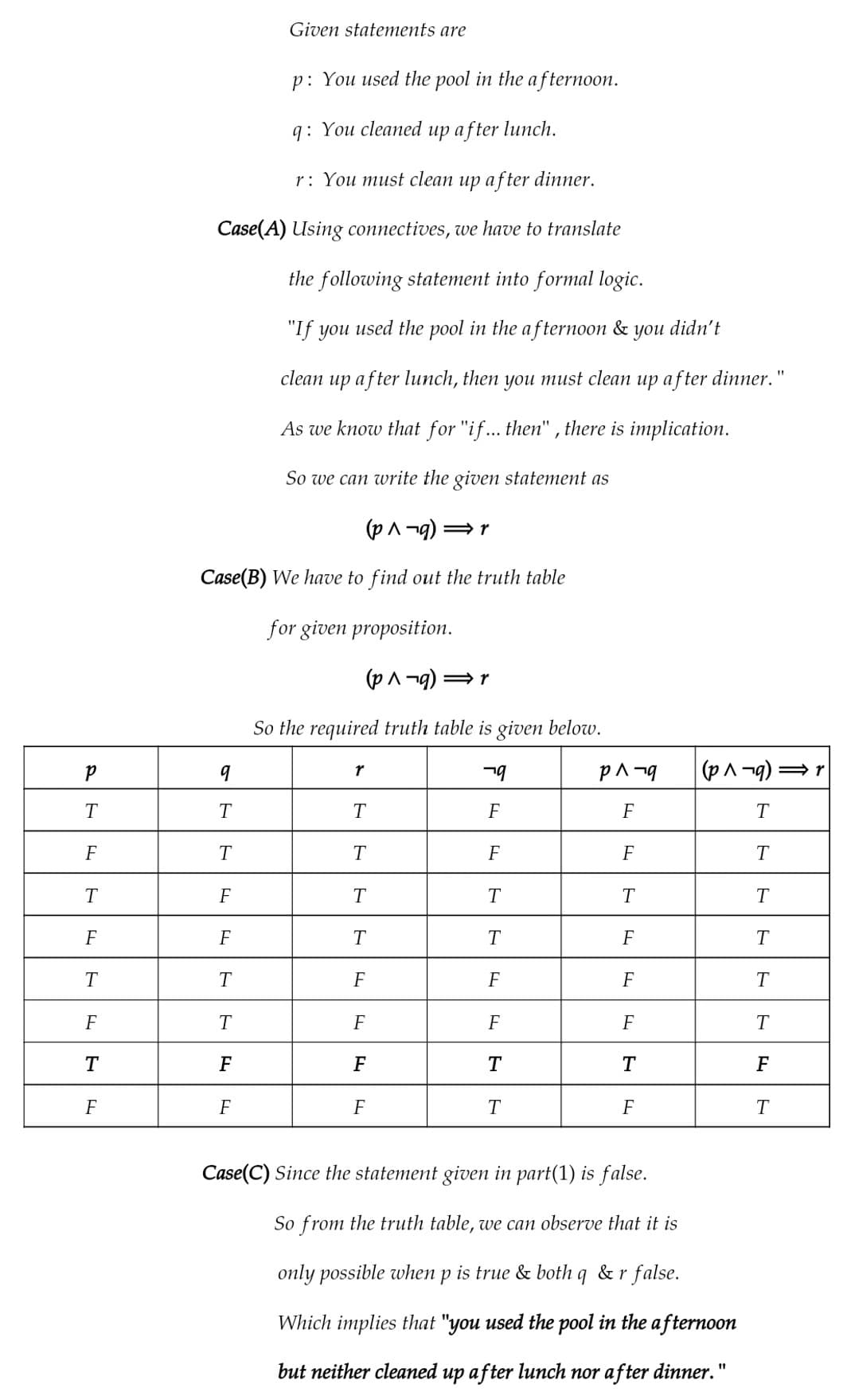In Activity 2 of last section, you translated the statement "If you used the pool in the afternoon and you didn't clean up after lunch, then you must clean up after dinner" into formal logic using the following variables. p = "You used the pool in the afternoon." q = "You cleaned up after lunch." r = "You must clean up after dinner." 1. Use the implication rule to rewrite your formal logic statement so that it doesn't contain the → connective. 2. Use De Morgan's laws to rewrite the resulting statement from part (1) so that it doesn't contain the A connective. 3. Use equivalence rules to simplify the negation of your statement from part (2) so that it doesn't use parentheses. 4. Without using truth tables, can you give an alternative explanation for your conclusion in part (3) of Activity 1.1.2?
In Activity 2 of last section, you translated the statement "If you used the pool in the afternoon and you didn't clean up after lunch, then you must clean up after dinner" into formal logic using the following variables. p = "You used the pool in the afternoon." q = "You cleaned up after lunch." r = "You must clean up after dinner." 1. Use the implication rule to rewrite your formal logic statement so that it doesn't contain the → connective. 2. Use De Morgan's laws to rewrite the resulting statement from part (1) so that it doesn't contain the A connective. 3. Use equivalence rules to simplify the negation of your statement from part (2) so that it doesn't use parentheses. 4. Without using truth tables, can you give an alternative explanation for your conclusion in part (3) of Activity 1.1.2?
Advanced Engineering Mathematics
10th Edition
ISBN:9780470458365
Author:Erwin Kreyszig
Publisher:Erwin Kreyszig
Chapter2: Second-order Linear Odes
Section: Chapter Questions
Problem 1RQ
Related questions
Question
100%
Need help with the next part of the activity. First image is the first part the 2nd part is referencing. Thank you.

Transcribed Image Text:In Activity 2 of last section, you translated the
statement "If you used the pool in the afternoon and
you didn't clean up after lunch, then you must clean
up after dinner" into formal logic using the following
variables.
p = "You used the pool in the afternoon."
q = "You cleaned up after lunch."
r = "You must clean up after dinner."
1. Use the implication rule to rewrite your formal
logic statement so that it doesn't contain the →
connective.
2. Use De Morgan's laws to rewrite the resulting
statement from part (1) so that it doesn't contain
the A connective.
3. Use equivalence rules to simplify the negation of
your statement from part (2) so that it doesn't use
parentheses.
4. Without using truth tables, can you give an
alternative explanation for your conclusion in part
(3) of Activity 1.1.2?

Transcribed Image Text:Given statements are
p: You used the pool in the afternoon.
q: You cleaned up a fter lunch.
r: You must clean up a fter dinner.
Case(A) Using connectives, we have to translate
the following statement into formal logic.
"If you used the pool in the afternoon & you didn't
clean up a fter lunch, then you must clean up af ter dinner."
As we know that for "if.. then" , there is implication.
So we can write the given statement as
d= (b- v d)
Case(B) We have to find out the truth table
for given proposition.
(pA -g) =r
So the required truth table is given below.
(p^ ¬9) =
F
F
F
T
F
F
T
F
T
F
F
F
F
F
F
F
F
F
F
T
F
F
T
F
F
F
F
F
Case(C) Since the statement given in part(1) is false.
So from the truth table, we can observe that it is
only possible when p is true & both q & r false.
Which implies that "you used the pool in the afterno0on
but neither cleaned up after lunch nor after dinner."
%3D
Expert Solution
This question has been solved!
Explore an expertly crafted, step-by-step solution for a thorough understanding of key concepts.
This is a popular solution!
Trending now
This is a popular solution!
Step by step
Solved in 2 steps with 1 images

Recommended textbooks for you

Advanced Engineering Mathematics
Advanced Math
ISBN:
9780470458365
Author:
Erwin Kreyszig
Publisher:
Wiley, John & Sons, Incorporated

Numerical Methods for Engineers
Advanced Math
ISBN:
9780073397924
Author:
Steven C. Chapra Dr., Raymond P. Canale
Publisher:
McGraw-Hill Education

Introductory Mathematics for Engineering Applicat…
Advanced Math
ISBN:
9781118141809
Author:
Nathan Klingbeil
Publisher:
WILEY

Advanced Engineering Mathematics
Advanced Math
ISBN:
9780470458365
Author:
Erwin Kreyszig
Publisher:
Wiley, John & Sons, Incorporated

Numerical Methods for Engineers
Advanced Math
ISBN:
9780073397924
Author:
Steven C. Chapra Dr., Raymond P. Canale
Publisher:
McGraw-Hill Education

Introductory Mathematics for Engineering Applicat…
Advanced Math
ISBN:
9781118141809
Author:
Nathan Klingbeil
Publisher:
WILEY

Mathematics For Machine Technology
Advanced Math
ISBN:
9781337798310
Author:
Peterson, John.
Publisher:
Cengage Learning,

